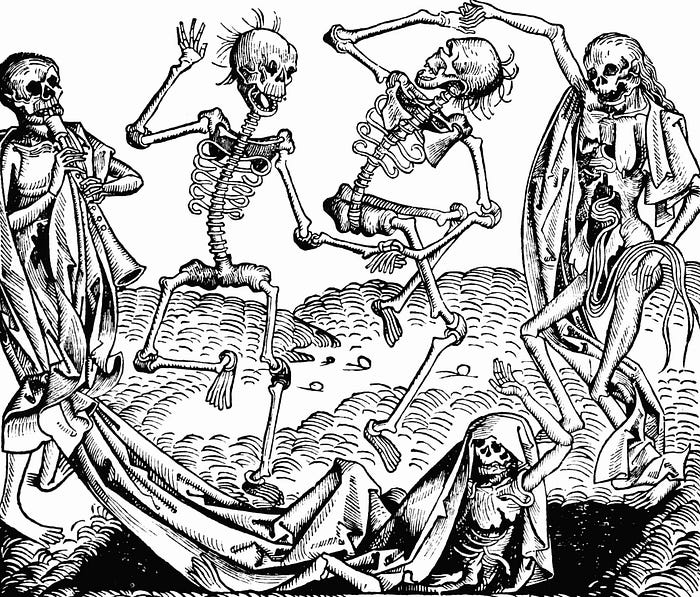

Why Past Life Expectancy Numbers Are Misleading
source link: https://grantpiperwriting.medium.com/why-past-life-expectancy-numbers-are-misleading-e90bc4282664
Go to the source link to view the article. You can view the picture content, updated content and better typesetting reading experience. If the link is broken, please click the button below to view the snapshot at that time.
Why Past Life Expectancy Numbers Are Misleading
The risks were not uniform

(Public domain)
The Roman Empire was the pinnacle of human civilization in the ancient world. They built roads across Europe, developed large and fast-flowing aqueducts, and planted their standard from Spain to Persia. People still travel by the millions to look upon their architecture with their own eyes and marvel at the things that human hands built millennia ago.
But the life expectancy in ancient Rome was a paltry 25 years old. That doesn’t sound grand at all.
Life expectancy during the Medieval Period hovered around 35 years of age. Even at the start of the 20th century, life expectancy was just 50 years old in many so-called developed nations.
Numbers like this evoke images of desolate wastelands where there are no elderly people. Where a village would have one fortunate soul that managed to live into their 50s. That is not the case at all.
In fact, a good number of people lived well into their 60s and 70s in the ancient world and the Medieval world.
The low life expectancy numbers are due to a quirk of statistics that do not paint a full picture.
Statistical Quirks
Life expectancy is a simple average that takes the ages of the deceased, adds them up, and then divides them. This can lead to some strange anomalies that people run with.
Take, for example, a mother who has four children. One child tragically dies shortly after birth. Another child lives to be 21 before dying in an unfortunate car accident. The last two children live to the ripe old ages of 81 and 99. The average life expectancy for this family is 50 years old despite the fact that none of the four children lived anywhere close to 50 years old. It is simply the average of all of their lives.
Take another example. Another mother has four children, except for this time, only one child dies in infancy, and the rest live to the average life expectancy of 80 years old. The life expectancy for this family is 60. That is despite the fact that 75% of the children lived 33% longer than their family’s supposed life expectancy.
A similar thing is happening with past life expectancy numbers.
Surviving Childhood Was a Bear
Childhood in the ancient world was exceedingly dangerous. The odds of living to just 10 years old were low. The odds of living to 5 years of age were lower than living to 10. The odds of living to just 1 year old were even lower still.
The older you managed to get in the ancient world, the better chance you had to reach advanced age. The exceedingly high rates of childhood mortality drag down the life expectancy to 25. But Rome was not a society filled only with teenagers. There were plenty of elderly people across the spectrum.
In fact, a glimpse of a typical metropolitan Roman city would not look much different than it does today. There were young kids running around, petulant teenagers, worn out middle-aged workers, and grumpy elderly heads of household.
The only difference would be that nearly everyone would have a relative that had died young. Whether it was a sibling that caught a fever when they were small or a mother who lost a pair of teenage sons to an accident on the road. The number of people who would have experienced tragedies like these was far higher than today, but people were not keeling over and dying at 30 as some people imagine.
Data compiled by a BBC study on this topic found that during the Medieval Period from 1200 to 1745, a man 21 years of age was expected to live to 64 years old. That tells us that if you managed to escape childhood unscathed, you had a good shot at living just as long as most people today do.
Another thing that throws off the numbers is periods of tragedy. The life expectancy in some parts of Europe during the peak of the Black Death was actually 45 meaning few people lived past that age. The plague slaughtered millions of people and hit children and the elderly harder than other groups. The longer you lived in a plague-stricken area, the greater your chance of catching the disease and the greater your chance of dying young.
Major wars had a similar effect. The Mongols raided and murdered tens of thousands of otherwise hale people slicing the life expectancy ahead of the eastern hordes by a sizable amount.
But these factors are not handled with any nuance. The numbers are simply thrown into a giant blender and spat out again. If you remove the plague and the Mongol murders from the Medieval life expectancy count, it would jump by quite a bit. Because the natural human lifespan hasn’t changed all that much in the past 3,000 years. The circumstances governing individual lives have changed.
If you lived in a village free from the plague and far from the Mongols in 1300, you likely had a good shot at living to 60 like anyone else. But the numbers don’t bear that out. The numbers are hamfisted, and they can be exceedingly misleading.
Conclusion
It would be better to focus on rates of childhood and infant mortality than it is to focus solely on a blanket life expectancy number. Nuance also dictates that it would be smart to divide these numbers into different ages, genders, professions, and regions.
Instead of saying that the life expectancy in ancient Rome was 25, you could say that a soldier was expected to live to 30 while an upper middle-class wife was expected to live to 65 on average.
Both Rome and Medieval Europe were dense, vibrant societies where plenty of people lived well into their 60s and 70s. If you escaped childhood, you had a nearly equal shot at living to 60 as you do today. The only difference is today, more people than ever reach adulthood.
At the end of the day, statistics are great. They are fun to parse through. They can distill a lot of dense information down into a digestible bite. But they can also be misleading and devoid of all nuance.
Recommend
About Joyk
Aggregate valuable and interesting links.
Joyk means Joy of geeK

